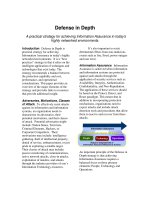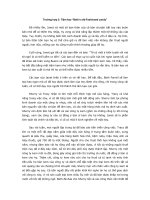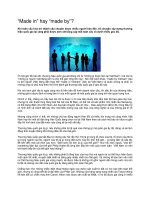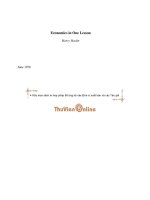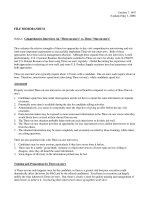Tài liệu Nonviolence in Hawaii''''s Spiritual Traditions, Edited by Glenn D. Paige ppt
Bạn đang xem bản rút gọn của tài liệu. Xem và tải ngay bản đầy đủ của tài liệu tại đây (360.71 KB, 135 trang )
Nonviolence in
Hawaii's
Spiritual Traditions
NONVIOLENCE IN HAWAII'S
SPIRITUAL TRADITIONS
Edited by
Glenn D. Paige and Sarah Gilliatt
Center for Global Nonviolence
2001
Copyright ©1991 by the Center for Global Nonviolence
Planning Project, Spark M. Matsunaga Institute for Peace,
University of Hawai'i at Manoa, Honolulu, Hawai'i 96822,
U.S.A.
Copyright ©1999 by the nonprofit Center for Global
Nonviolence, Inc., 3653 Tantalus Drive, Honolulu, Hawai'i,
96822-5033. Website: www.globalnonviolence.org.
Email: ;
Copying for personal and educational use is
encouraged by the copyright holders.
ISBN 1-880309-00-9 (alk. Paper)
BL65.V55N66 1991
Religions are different roads
converging on the same point.
M.K. Gandhi
CONTENTS
Preface
Hawaiian
Lou Ann Ha'aheo Guanson
1
Baha'i
Tony Pelle
13
Buddhist
Robert Aitken
29
Christian
Stanley Amos
39
Anna McAnany
51
Hindu
Gurudeva Sivaya Subramuniyaswami
61
Islamic
Wasim Siddiqui
81
Jewish
Ira J. Lichton
89
Religious Society of Friends (Quaker)
Ruth Anna Brown
101
Suggestd Reading
117
Contributors
121
Editors
122
Index
123
vii
Preface
These essays were first presented as brief talks given in
Kuykendall Auditorium on the campus of the University of
Hawaii at Manoa on January 11, 1990. They were offered as
contributions of the Center for Global Nonviolence Planning
Project to celebrate the Hawaii State Martin Luther King Jr.
Holiday Week in cooperation with the King Holiday
Commission chaired by Dr. Donnis Thompson.
We are privileged to be able to present these insights into
nonviolence in Hawaii's spiritual traditions and are deeply
grateful to the authors for sharing them. We recognize, as does
each of them, that interpretations can vary within each tradition.
Therefore none of them claims to speak for all adherents of their
faith. Nevertheless each voice is an authentic one and merits
most thoughtful reception.
Each contributor was invited to address, if appropriate, one
or more of the five principal questions that guide the research
interests of the Global Nonviolence Planning Project. That is, of
each spiritual tradition we asked for insights into (1) the causes
of violence, (2) the causes of nonviolence, (3) the causes of
transition between violence and nonviolence, (4) the
characteristics of a completely nonviolent society, and (5)
implications for action.
We recognize also that not all of Hawaii's faiths and, of
course, not all relevant world faiths are represented here. We
hope that those who wish to share insights into nonviolence in
PREFACE
viii
other traditions, as well as in the present ones, will contribute
them so that future presentations can assist greater breadth and
depth of understanding. What we have demonstrated here
locally can be done in other societies and indeed globally.
We hope that the people of Hawaii, visitors to Hawaii, and
people everywhere will find this little book useful in reflecting
upon the roots of respect for life in their own spiritual and
humanist traditions. For it is out of such roots that the promise
grows realizing a nonviolent society in Hawaii and in the world.
Against divisive violence, these essays affirm nonviolent
spiritual community. We hereby record respectful appreciation
to all those who helped to make this exploration of nonviolent
culture possible, including the Faculty Council of the Spark M.
Matsunaga Institute for Peace, Francine Blume, Lou Ann
Ha'aheo Guanson, Peter Miller, Christine Nahuanani Patrinos
S.N.J.M., and the people of Hawaii. We are indebted to Stanley
Schab for technical assistance. The first printing of this book
was made possible in part through the generosity of Professor
Theodore L. Herman, Director Emeritus of Peace Studies,
Colgate University, and founder of the Nonviolence Study
Group, International Peace Research Association. This second
printing was made available through the kindness of Dr. Ruth
Anna Brown.
Glenn D. Paige
Sarah Gilliatt
October 1992
1
Hawaiian
Lou Ann Ha'aheo Guanson
'0 na Kumu akua a pau i hanau 'ia i ka Po
Oh original gods born in remote antiquity
i ka La hiki ku;
where the sun rises;
Ea mai ke kai mai!
Rise up out of the sea!
'0 na Kumu ali 'i a pau i hanau 'ia i ka Po
Oh original chiefs born in remote antiquity
i ka La hiki ku;
in the sunrise;
Ea mai ke kai mai!
Arise from the sea!
'0 na Lala ali'i a pau i hanau 'ia i ka Po
Oh relatives of all the chiefs born in remote antiquity
i ka La hiki ku;
in the sunrise;
HAWAIIAN SPIRITUAL TRADITION
2
Ea mai ke kai mai!
Arise from the sea!
'0 na Welau ali'i a pau i hanau 'ia i ka Po
Oh distant kin of all the chiefs born in remote antiquity
i ka La hiki ku;
where the sun rises;
Ea mai ke kai mai!
Arise from the sea!
'0 na Pua ali 'i a pau,
Oh descendents of the chiefs
E ku e ola!
Stand up and live!
A kau a kaniko'o, pala lau hala
Live to remote old age!
Haumaka 'iole Kolopupu!
Stand until the support of a cane is needed!
1
The Hawaiian traditions were passed on orally through the
prayers and chants of the people. To fully appreciate the depth
of the tradition, one must hear the melodic sounds of the voices.
Here, an attempt is made to convey in written form the oral
traditions of the Hawaiians.
The spiritual traditions of the Hawaiians are integrated into
the, Hawaiian culture. Their spirituality and everyday life are,,
woven together, Ua hilo 'ia i ke aho a ke aloha, "braided with
the cords of love." The Hawaiians are gentle natured people
living in deep spirituality with the land. Their gentleness is
reinforced by the communal life on an island. Their spirituality
GUANSON
3
is strengthened by the land and other elements of nature. The
prayers and chants of the Hawaiians acknowledge the divine
spirits within all people and the things around them. In the
Hawaiian religious tradition there exists a universal equilibrium
between humanity and nature to maintain the harmony in heaven
and on earth. To maintain this equilibrium, the Hawaiians
worship many gods. The gods provide qualities and values to
guide the people. The gods Kane, Ku, Lono, and Hina
exemplify important principles and values to the people.
Kane, the leading god, is known as the creator of humanity,
symbol of life and nature, god of fresh water and sunlight and
forests. He is the giver of life. He possesses the qualities of
benevolence and creativity. Kane represents the omnipresence
of the divine spirit of nature and the interconnectedness of nature
and humanity.
Ku, meaning upright, represents male generating powers.
Ku is the god of war, both offensive and defensive. More
important is the defensive role of protector and defender of the
people. Ku exemplifies the values of respect, pride, moral
courage, and valor. His responsibilities include rain, fishing,
sorcery , and planting. Since his generative powers are more
important than war, Ku is symbolized by the agricultural tool,
the o'o (digging stick) which, at one time, was functional for
economic development and productivity.
Lono, the god of peace, exemplifies healing, mercy and ,
hospitality. During makahiki, a four month festival, Lono
outlaws war. He represents and achieves the people's desire for
peace. In addition, Lono is considered the god of clouds, winds,
rain, and fertility. In this capacity, he symbolizes giving and
generosity.
Hina, the god of female generative powers of fertility, was
the counterpart of Ku as the expression of male generative
HAWAIIAN SPIRITUAL TRADITION
4
powers. Hina expresses energies of reproduction and growth.
Ku is erect; Hina is supine. Hina is the left hand; Ku is the right.
Hina is one of the major gods of medicine and fishing. Hina and
Ku represent the equilibrium and harmony for well being.
The principles and values of the gods are emulated by the
people. In their worship they live these values daily and
integrate the values into their way of life. The deep spirituality
of the Hawaiians of the past help to maintain a consistent state of
prayer. As the Hawaiians looked at the beauty of the flowers or
the richness of the soil, they were in prayer with the gods. Mary
Kawena Pukui states that the Hawaiians were haipule, religious.
"Everything they did, they did with prayer. " The lessons from
the gods are taught and passed on in the oral tradition. The
following is a pule (prayer) to the gods asking for wisdom and
power:
E 'Io e, e 'Io e,
O 'Io, o 'Io
'E ku, e manu e
O stand, o bird
Ke alu aku nei ka pule ia Hakalau
Combine prayers to overcome Hakalau
Kulia ka lani ia Uli
The heavens-high-one strives to obtain Uli in prayer
la namu ia nawe
To mutterings, to pant for breath
Ka nehe i luna, ka nehe i lalo
The rustlings above, the rustlings below
GUANSON
5
Ka'a 'akau, ka'a hema
Roll right, roll left.
Ku makani ha'i ka lani
The wind that splits the heavens,
Hekili ka'aka'a i ka lani
Thunder that rolls again and again
Kauila nui Makeha i ka lani
The great lightning that slashes in the heavens
Pane i ka lani e ola ke kanaka
Answer to the heavens, let the man live.
Ho mai ka loea, ka 'ike, ka mana
Bring cleverness, knowledge, supernatural powers
I a'e ka honua la
So that earth may ascend
'O waha lau ali'I
By the mouth of many chiefs
'O kahi i waiho ai ka hua 'olelo
The place where words are left.
'Eli'eli kau mai
Profound is the tabu that rests upon it
'Amama. Ua noa.
The prayer is said, the tabu is over.
2
The gods in turn passed on the power or mana they
represent to the people. Through the mana one develops an
awareness of unity and mutual interrelationship of all that
HAWAIIAN SPIRITUAL TRADITION
6
surrounds the individual. The mana is passed on through a
spoken declaration or passed on by ha, a breath of life. Mana of
the prayer was in the word and names, but it was also the breath
that carried the words and names. In the ritual of ha, a person's
last breath is passed with the giving of mana of a specific talent
or natural aptitude. Thus this power of keen insight,
understanding, and sensitivity is given to chosen individuals to
share and pass on. The poetic vision and values are shared
through the breath.
This ha, the breath of life or breath of god, along with alo
meaning bosom or the center of the universe, forms the word
aloha. Aloha is the feeling and recognition of the divine in
everyone. Aloha is a view of life and a state of mind and heart.
The spirit of god, whichever form it takes, is in everyone.
Consequently, the understanding of aloha necessitates the
treating of everyone with reverence and gentleness. Therefore,
one cannot mistreat or judge another. We each are given the
responsibility of being a guiding light for one another.
In the words of Pilahi Paki, "the Aloha Spirit is the
coordination of the mind and heart it's within the individual it
brings you down to yourself. You must think and emote good
feelings to others. Permit me to offer a translation of the word
aloha: A stands for akahai meaning kindness, to be expressed
with tenderness, L stands for lokahi meaning unity, to be
expressed with harmony, O stands for 'olu'olu meaning
agreeable, to be expressed with pleasantness, H stands for
ha'aha'a meaning humility, to be expressed with modesty, A
stands for ahonui meaning patience, to be expressed with
perseverance."
3
Without aloha violence may follow. In the Hawaiian
tradition, one major cause of violence is the loss of harmony
within the self, in relationships with others, and with the 'aina
(land). Harmony is lost through lowered self-esteem, harbored
GUANSON
7
anger and hostility toward others, and the separation from nature
and the environment. More specifically, Nana I Ke Kumu [Look
to the Source]
4
explains the various causes for violence: personal
vengeance resulting in loss of prestige, revenge for mistreatment
of a revered leader, boredom with peace, and love of combat.
The major cause of war and violence was the dispute over
possession of land that caused people to kill.
However, to control the violence caused by war, Hawaiians
established ways to limit warfare. The most effective was the
Makahiki ceremony depicting the return of the god Lono to
Hawai'i. During the four month period each year this was a time
of festivals, harvest, taxes, games, and sports. All warfare was
halted. Other less effective control measures to limit violence
include periods of truce, total abandonment of battle by mutual
consent usually by revelation of ho'ailona (omens), and 'ohana
relationships (extended family) by chiefs realizing their family
ties.
Another cause of violence is the oppression by those in
power and control. The oppressor subjugates the values, way of
life, and beliefs of the powerless. This may take the form of
foreign invaders suppressing the land and its people. Another
form may be a subtle deculturation process through an
educational system which teaches the perspective of the
dominant culture. This form of structural violence, serving the
interests of the dominant groups, demeans the subordinated
individuals. The individuals lose their dignity and self-worth
which in turn generates further hostility.
To arrive at nonviolence, Hawaiians designed various
activities to maintain harmony for the individual and society. In
the cultural religious tradition, Hawaiians practiced non-
violence by channelling or neutralizing aggression and violent
forms of expression. They redirected energies physically to
release tension and provide time to play.
HAWAIIAN SPIRITUAL TRADITION
8
Ho'opapa, an intellectual and poetic contest of wits, was
developed as a nonviolent form of battle. Ho'opapa takes the
form of pitting one person's skills against another by composing
chants and riddles using certain words, puns, and sounds. Skills
required for success went beyond logic to creative use of vast
storehouses of know ledge.
Another form of nonviolent activity is to focus positive
energies to fight common social ills such as environmental
pollution and nuclear disarmament. The social ill serves as a
common bond for the mass energy.
In addition, rules of proper etiquette to maintain
harmonious relationships were taught. Hawaiians strongly
believed in preventing violence by developing nonviolent
harmonious social behaviors. They were careful in the words
they used for fear of offending or hurting someone's feelings.
The most important cause of nonviolence is aloha. Aloha
neutralizes violent actions and aggression. Aloha within the
'ohana from birth, childhood, and adulthood provides positive
reassurance and feelings of support for the individual.
Nonviolence is developed and strengthened by living out
the spirituality that god is everywhere and in everyone. If god is
everywhere and in everyone, then we could not and would not
destroy or hurt anyone or anything around us.
Hawaiians of old attempted to treat others with much care
for the spirit of god dwelling in all. In particular they generously
shared their hospitality with all, including strangers. An old
Hawaiian saying states, "'0 Ke aloha Ke Kuleana o kahi
malihini. Love is the host in strange lands." Through this
spiritual understanding that god is ever-present, the common
overrides individual greed and gain. The welfare of others
becomes more important than personal gratification. By realizing
GUANSON
9
that one's survival and welfare are dependent upon a harmonious
relation with other people and objects, one is led to harmonious
actions and nonviolence.
To make the transition from violence to nonviolence in the
Hawaiian spiritual tradition, individuals must feel loved and
nurtured in an environment of acceptance and tolerance. The
'ohana, or the extended family setting, provides a loving support
to break away from violence. Through the giving of aloha in the
ohana, the individual's violence may be transformed
The nonviolent society as envisioned by Hawaiians,
includes the following essential values integral to the Hawaiian
spiritual tradition: a deep reverence and respect for all living
objects: laulima working cooperatively together for the good of
the community; pono justice, righteousness, and hope; lokahi
harmony in unity; ho'okipa hospitality; lokomaika'I generosity
and goodwill; kokua mutual help and cooperation; 'ohana-
extended family, the sisterhood and brotherhood of humanity as
central focus of relationships; aloha 'aina love for the land,
understanding the interdependence of humanity and the
environment; malama caring for each other; aloha the
overriding value of love and care for others.
These values need to be articulated, taught, and nurtured by
all on this planet.
In addition to values to live by, a nonviolent society needs
to practice a process of dealing with problems and conflicts as
they arise. The Hawaiian process is called ho'oponopono.
Ho'oponopono is a process of putting things right with the
whole person and god and giving reverence to life.
Ho'oponopono is a process of forgiving each other. The
Hawaiians never parted still angry after a disagreement. The
families of both parties would come together to work out the
HAWAIIAN SPIRITUAL TRADITION
10
problem. The individual must sincerely plead, "Please forgive
me in thought, word, and deed if I have done anything to hurt
you." This begins the process. Some basic rules include:
keeping things simple by not being so entangled and caught up
in the words that one forgets the feelings, forgiving at the
forefront of the agenda, the need and desire to be healed
mentally and spiritually, getting right with god releases the
tension, pressures, and guilt, maintaining the proper
In Nana I Ke Kumu Pukui describes the essentials of
ho'oponopono: pule opening pule or prayer as well as prayers
at any later time when it seems necessary; kakulu kumuhana
statement of the problem to be resolved; mahiki the "setting to
rights" of each successive problem, self-scrutiny and discussion
of individual conduct, attitudes, and emotions; 'oia'i 'o quality
of truthfulness and sincerity, channel through which the leader
controls disruptive emotions, leader questions participants,
honest confession to god and each other, immediate restitution;
midi and ala repenting, forgiving, releasing from the guilt's and
grudges; closing pule ho' omalu period of silence to encourage
self-inquiry and calm tempers.
5
On an individual level, we need to renew the spiritual
source of the Hawaiian religious and cultural tradition to move
toward a nonviolent society. We need to live life with the
understanding of the relationship between the spirit of the people
and the spirit of the earth. There is spirituality and physicality in
all our actions and in who we are in our daily lives. The
sustenance for this life comes from the land, water, and air. We
need to live this way of life in harmony with nature.
The environmental movement with its call to save and care
for the planet is raising the consciousness of the people to the
interconnection of all living things to the land, water, and air. It
is calling for a simple lifestyle that does not harm the earth.
Environmentalists are reaffirming what Hawaiian and other
GUANSON
11
native peoples of the planet have known all along. By caring for
the land and the earth itself, we come into harmony with what is
around us.
On a public policy level, to move our society toward more
nonviolent conditions, we must provide an independent land
base for native people to practice and perpetuate their culture and
religious traditions. Without access to land, particularly in a
place like Hawai'i, violence is created by denying the important
spiritual link to the land. Around the world, native people are
claiming their birthright to land as a cultural and spiritual link to
who they are. Nonviolent conditions may be created by policy
makers by allowing the native people rightful claim to their land.
Until this is done, cultural genocide and oppression of these
native people hang over each one of us. For it is the native
people of the planet, and Hawaiians as a particular example, that
culturally have a spiritual tradition of nonviolence that can serve
as an example to others. This nonviolent spiritual tradition calls
for the harmony between people, culture, and the environment.
Another recommendation for public policy action for a
more nonviolent society is the creation of pu'uhonua, places of
refuge. Pu'uhonua are designated sacred areas within which no
blood can be shed nor unkind word spoken. Pu'uhonua can
serve as zones of peace in areas of war or provide shelter for
those suffering physical and psychological abuse a place of
refuge for all to go for renewal and protection.
NOTES
1. June Gutmanis,
Na Pule Kahiko
(Honolulu: Editions Limited,
1983), p. 2.
2. Ibid.,pp.113-114.
HAWAIIAN SPIRITUAL TRADITION
12
3. George Chaplin and Glenn D. Paige, eds.,
Hawaii 2000
(Honolulu: University of Hawaii Press, 1973), pp. 70-71.
4. Mary Kawena Pukui, E. W. Haertig, and Catherine A. Lee,
Nana I Ke Kumu
, Vol. I (Honolulu: Hui Ha' Nai, Liliuokalani
Trust, 1972), pp. 60- 77.
5. Ibid.
13
Baha'i
Tony Pelle
Introduction
Baha'is are not strangers to violence. The persecutions of
the Baha'i Faith in Iran, a Moslem nation, began as soon as the
religion itself was born in 1844. The Bab (1819-1850), Prophet-
Herald of the Faith and Forerunner of Baha'u'llah (1817-1892),
Prophet-Founder of the Baha'i Faith, was martyred. In the early
years of the Faith over 20,000 members were martyred.
Baha'u'llah suffered persecution, imprisonment, banishment, and
exile. Persecution of Baha'is continues intermittently to the
present day. Baha'i holy places have been seized and in many
cases destroyed. Elected officials of the Faith have been
kidnapped and executed. Baha'is have been beaten, raped,
terrorized and executed without trials. Cemeteries have been
desecrated, private property looted and destroyed, life savings
confiscated, and children expelled from schools. Again in Iran,
Baha'is are officially considered non-persons and are deprived of
their human rights.
Many governments of the world have appealed to Iran on
behalf of the Baha'is and they have had some effect in reducing
the severity and violence of the persecutions.
Why the persecutions? Why the violence directed against
the Baha'is, particularly in the land of its birth? The Baha'i
BAHA'I
14
Community is the largest minority in Iran. Some of the reasons
for the persecution are:
*Baha'is believe that Baha'u'llah is the Bearer of God's
Word for this Age in the line of Abraham, Krishna, Moses,
Buddha, Christ, and Muhammad. Baha'u'llah claims that all true
religions come from the same Divine Source, that all the
Prophets of God proclaim the Word of God, and that religious
truth is continuous and relative, not final and absolute.
*Baha'i teachings include the independent search for truth,
abolishment of all prejudices, equality of men and women,
harmony of science and religion, compulsory and universal
education, abolishment of extremes of wealth and poverty, and a
call for world unity and peace.
*The three basic principles of the Baha'i Faith are the
oneness of God, the oneness of religion and the oneness of
humankind. All of these are seen as threats by Islamic
fundamentalists.
How have Baha'is reacted to all the violence directed
against them? They have responded with nonviolence. While
obeying the government in all its laws and actions against them,
the Baha'is made it clear that they remained steadfast to their
Faith. The Baha'is of Iran, like the early Christian martyrs, have
refused to recant their Faith, even when offered their lives in
return for pro forma recantation of their Faith. They are firm in
their love for their religious beliefs and have given up their lives
for these beliefs.
What makes them withstand the violence directed against
them and if need be willingly give up their lives for their beliefs?
Justice is a central concern of the Baha'i Faith and is seen
as the expression of love and unity in the life of a society.
PELLE
15
Baha'is have accepted Baha'u'llah as the standard of justice for
our age and the source of divine law. Baha'u'llah taught that a
new world, a world civilization, can only be built by a new race
of men and women whose actions reflect values of love, unity
and justice that apply equally to all peoples.
Nonviolence and the Baha'i Faith
Baha'is completely reject the use of force to bring about a
change in human affairs. They reject violence because it has its
roots in lawlessness, it denies human rights due to all men, and it
is contrary to moral law. Baha'is believe in the sanctity of all
life. This includes nature which is to be respected and protected
as a divine trust for which we are answerable.
Baha'u'llah states "Spread not disorder in the land, and shed
not the blood of anyone."
1
"Sanctify your ears from the idle talk of them that are the
symbols of denial and the exponents of violence and anger "
2
"Say: Fear God, O people and refrain from shedding the
blood of anyone. Contend not with your neighbor, and be ye of
them that do good. Beware that ye commit no disorders on the
earth after it hath been well ordered and follow not the footsteps
of them that are gone astray."
3
"He [God] hath, moreover, ordained that His Cause be
taught through the power of men's utterance and not through
resort to violence."
4
Abdu'l-Baha (1844-1921), son of Baha'u'llah who shared
imprisonment with His father and visited the United States in
1912, states: "Fighting and the employment of force, even for
the right cause, will not bring about good results, the oppressed
BAHA'I
16
who have right on their side must not take that right by force; . . .
the evil will continue. Hearts must be changed."
5
A Baha'i White Paper issued by the US Baha'i Community
states: "We abhor killing and will never voluntarily place
ourselves in a position where we must take human life."
6
Baha'u'llah teaches that we should protect animals. "Look
not upon the creatures of God except with the eye of kindliness
and of mercy, for Our loving providence hath pervaded all
created things and Our grace encompassed the earth and the
heavens."
7
"Shoghi Effendi (1896-1957, Guardian of the Baha'i Faith)
links the preservation of the earth's resources with both the
'protection (of the) physical world and (the) heritage of future
generations.'"
8
Causes of Violence
The causes of violence are many and complex. They come
from our experiences as individuals, as members of families, and
as members of society.
"Aggression and violence are acquired behaviors which are
neither innate nor inherited. (The exception is violence
occurring under pathological medical conditions). They are the
results of faulty views of the nature of man and the purpose of
life."
9
How we view and understand good and evil, the purpose of
life, threats and opportunities, attitudes about death and
immortality affect our personal attitudes and are elements
contributing to the amount of violence in the world today.
PELLE
17
"A 10-year longitudinal study concluded that aggressive
behavior is shaped by learning through socialization practices."
10
"Observation by many social scientists indicate that one
major cause of the ever-increasing presence and occurrence of
violence and destruction in all societies is the discrepancy
between the goals of the individual and those of his
community."
11
"Societies with a greater degree of competition,
individualism and hierarchical structuring display a
correspondingly greater amount of aggression and
destructiveness. The competitive individual sets himself apart
from his fellow men, thus causing division which can lead to
aggression among the disunited lot."
12
"Life without meaning results in despair, destruction,
apathy and violence."
13
Alan Watts states that man is violent because he identifies
his real self with the ego the ego which is continually striving
against itself, society and nature.
Causes of Nonviolence
Why do people use nonviolence instead of violence? There
are several reasons and the following are a few.
1. The religious and/or spiritual background of the individual:
his or her moral value system.
2. Specific prohibitions in their religious or philosophical
beliefs against violence.
3. The conscious decision of the person or the aversion of the
person against violence.
BAHA'I
18
4. The disgust of persons against acts of violence and their
devastating results.
5. Nonviolence is part of the culture of the society in which the
person is brought up.
Ruth Benedict sees aggression or violence in a society
developing from the disharmony between an individual's
objective and the wishes, norms and values of that society.
14
She
states that "societies where non-aggressiveness is conspicuous
have social orders in which the individual by the same act and at
the same time serves his own advantage and that of the group."
15
When the individual's and the community's objectives are
in opposition many problems are caused for the individual
including frustrations, fear and anxiety all conducive to the
development of aggression and violence.
16
The teachings and beliefs of the Baha'i Faith negate
violence and promote the use of nonviolence. The prime
characteristic of the Baha'i community is unity.
"This unity is universal in nature and all-embracing in
scope. It includes the development and safeguarding of love and
harmony between the members of the community, as well as
complete harmony and cooperation between those institutions of
the Faith on the one hand, and between those institutions and the
members of the community on the other."
17
"This unity and love for each other among Baha'is is
attained through the knowledge of God, so that men see the
Divine Love reflected in the heart. Each sees in the other the
Beauty of God reflected in the soul and finding this point of
similarity, they are attracted to one another in love. . . . This love
will bring the realization of true accord, the foundation of true
unity."
18



